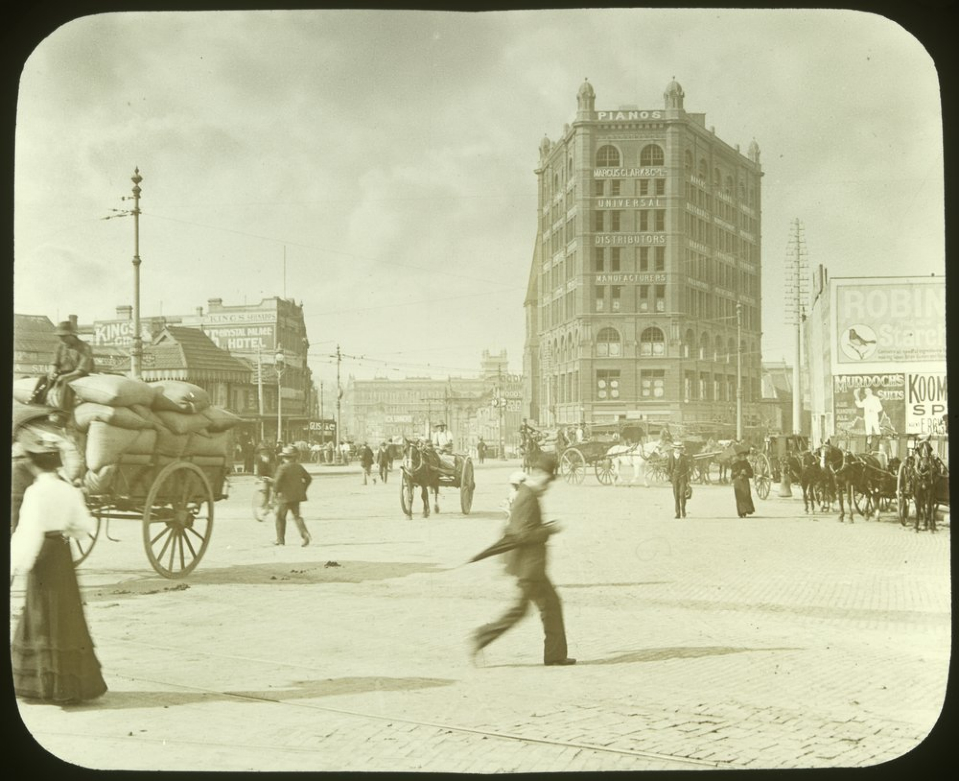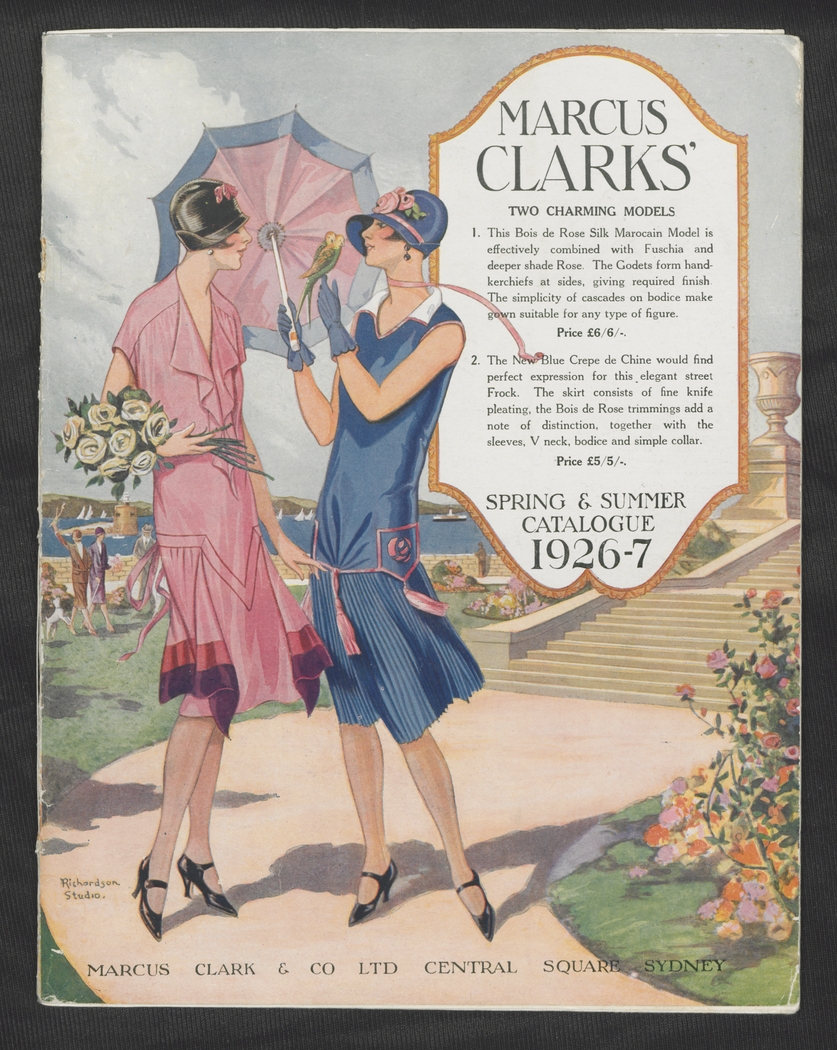The Dictionary of Sydney was archived in 2021.
Marcus Clark and Co
Citation
Persistent URL for this entry
To cite this entry in text
To cite this entry in a Wikipedia footnote citation
To cite this entry as a Wikipedia External link
Marcus Clark & Co
From a modest start in the Sydney suburb of Newtown in 1883, Marcus Clark & Co rose to become one of the city's largest department stores, with a network of branches in towns and suburbs across Australia. Henry Marcus Clark established the company when he purchased the drapery business of his former employer, John Kingsbury. The business quickly expanded, trebling itself within five years, and soon opened new stores in Marrickville and Bondi Junction. [1] In the Sands Directory for 1894, Marcus Clark was listed as a
wholesale and retail draper, tailor, milliner, boot warehouse and fancy repository; the largest, best lighted and most comfortable establishment in Newtown, the floor space covering nearly an acre. [2]
In 1896 Marcus Clark & Co opened a store closer to the city on the corner of George and Harris streets near Railway Square. It was, however, a slightly different concept as it stocked less expensive wares than the other stores, and was given the name Bon Marche, a reference to both the famous Paris department store and the store where Henry Marcus Clark had been apprenticed in Liverpool, England. [3] The success of the store led to a larger building being constructed on the site in 1909, but also influenced Henry Marcus Clark to build more stores around Railway Square.
Marcus Clark & Co [media]made arguably its biggest and most lasting mark on Sydney in 1906 when the James Nangle-designed Central Square building was erected at the corner of George and Pitt streets, at Railway Square, on the site of an early toll-gate. The new structure was modelled on the Fuller building in New York, commonly known as the flat-iron building. Henry Marcus Clark probably became aware of this building on an overseas trip, while his interest in architecture may have influenced his decision to construct one of Sydney's earliest skyscrapers. For all visitors entering the city from the south, it was an impressive sight: a landmark nine-storey structure of 150 feet in height, the tallest in Sydney at the time. [4]
The new station
The decision by Marcus Clark to build at Railway Square was also influenced by the extension of Sydney's Central Railway Station (now known as the country trains terminal) north from near Redfern to its current location – the new station was opened and received its first train in 1906. Before the city circle loop was built (the first part completed in 1926 and the second in 1932) passengers were forced to alight at Central, creating an instant potential customer base for Marcus Clark & Co. The development of this part of the city led the Sydney Morning Herald to comment that once the current array of buildings were completed,
the southern end of the city will no longer be the home of the Chinese and vendors of fruit, vegetables and fish, but will become a very important centre. [5]
By 1906, the company employed 600 staff, having started with just six in 1883, and it had for some years used the moniker 'Universal Distributor' to describe the enormous range of its stock and activities. One of the keys to Marcus Clark & Co's success was that by offering both mail order sales and well developed credit facilities, the company could greatly expand its customer base. In 1913, the company boasted that it had 100,000 customers on its books. Unlike other large Sydney stores, such as Anthony Hordern & Sons and Mark Foy's, which relied solely on cash sales, Marcus Clark & Co's strong reliance on the furniture and furnishing trade meant that it could only capture a large slice of this business, especially of those on lower incomes, by offering credit. A time-payment scheme was set up, that by 1905 was called the Gradual Payment System. A booklet produced shortly after this date to spruik the Gradual Payment System stated that 'if you had to wait until you saved enough money to pay cash, you might never be in a position to furnish a home'. [6]
[media]In 1913, the success of the business led to the construction of a new Spain & Cosh-designed nine-storey building across the road from the existing Railway Square store to house the furniture and furnishing departments. By this time, much of the furniture sold by Marcus Clark & Co was manufactured in its own factories. In addition, quilt, bedding and clothing factories helped fill the company's retail outlets. Although a bedding factory was located in Newtown, other manufacturing works as well as warehouses and stables were situated in and around Mountain Street, Ultimo, in a series of buildings erected by the company's own staff. These employees were also responsible for fitting out a number of large houses (such as Glenferrie at Neutral Bay and Clifton at Kirribilli), apartment blocks (Beulah Flats) and at least 12 theatres around Australia. [7]
Suburban and country expansion
[media]Henry Marcus Clark's early experience in Newtown may have alerted him to the advantages of regional and suburban retailing. Although a number of large retailers opened branches outside the city after World War II, Marcus Clark & Co's growth was unprecedented: the 1915 Sydney Sands Directory listed stores in Sydney suburbs of Newtown and North Sydney as well as the regional centres of Armidale, Dubbo, Goulburn, Gunnedah, Inverell, Lismore, Lithgow, Narrabri, Newcastle, Nowra, Tamworth and Wollongong. [8] Many of these country locations were actually modest-sized 'sample rooms' rather than large stores. However, they could still provide customers with personalised service and they competed directly with city retailers like Anthony Hordern & Sons, which made large profits from the lucrative mail order trade. Marcus Clark & Co's city stores had the added advantage of being conveniently located next to the parcels post office at Central Railway.
Henry Marcus Clark died near the peak of the firm's activities in 1913. At his funeral the Sydney Morning Herald reported that 700 male employees walked before the hearse while 300 female employees waited at Waverley Cemetery dressed in white with black sashes. [9] The firm passed to the able control of Henry Marcus Clark's son, Reginald Marcus Clark, who was knighted in 1939 and then known as Sir Marcus Clark. [10]
Building activities continued after World War I with the construction of a new pavilion in 1920 at the Royal Agricultural Society's show grounds at Moore Park. This was followed by the extension in 1928 of the furniture building at Railway Square into Marcus Clark & Co's main premises. The new construction was also designed by architects Spain & Cosh – it added a clock tower and more than tripled the floor space. The old store, the flat-iron building at Railway Square, now became redundant and after several unsuccessful sales attempts, it was eventually resumed by the Department of Railways in 1946. [11]
[media]In 1926, the company acquired a controlling interest in the Adelaide department store, Miller Anderson Limited. However, the depression years of the 1930s limited further expansion. Business grew strongly after World War II and following the death of Sir Marcus, his brother Roland Cuthbert Clark took the reins of the company. A number of second- and third-generation Clark family members were also involved in the management of the company as employee numbers almost reached 2000 in 1958. [12]
Change and decline
By the early 1960s, retailers in the city, particularly south of Park Street, were experiencing financial difficulties due to changes in demographics and shopping patterns in Sydney. Large sections of the population were moving further from the city centre and increasingly going to purpose-built suburban shopping centres with easy car access. Marcus Clark & Co attempted to combat this downturn by moving its Bon Marche store to the Sydney suburb of Liverpool in 1961, undertaking a complete reorganisation and modernisation of their Railway Square store in 1963, and proposing the establishment of a car park for up to 1000 vehicles at Railway Square. [13]
Despite attempts to salvage profitability, Marcus Clark & Co's demise was hastened by steeply growing bad debts – almost £250,000 was written off in 1964. An attempt to tighten control over customer credit only led to a drastic decrease in sales. [14] Issuing credit to large numbers of customers at the turn of the twentieth century had greatly increased Marcus Clark & Co's profitability but ironically, the same tactic in the early 1960s only led to the demise of the company. The Railway Square store closed in July 1965 and the company was taken over by rival department store, Waltons, in 1966. [15] The old flat-iron building has subsequently had various lives, including as a branch of the State Lotteries Office, and was restored in 1984 but without reattaching the 10-foot high masonry domes originally located on each corner of the roof. The main store, still known as the Marcus Clark building, is now home to the Sydney Institute of TAFE.
Notes
[1] Marcus Clark & Co Ltd, A souvenir of the success of Marcus Clark & Co Ltd, Sydney, c1913; 'Building a big business', Journal of the Retail Traders' Association of NSW, February 1924, pp 201–204
[2] Sands' Sydney and suburban directory, John Sands, Sydney, 1894, p 587
[3] Frances Pollon, Shopkeepers and shoppers: a social history of retailing in New South Wales from 1788, Retail Traders' Association of NSW, Sydney, 1989, pp 82–83
[4] Sydney Morning Herald, 17 January 1905, p 8; 27 February 1906, p 8
[5] Sydney Morning Herald, 3 October 1905, p 8
[6] Marcus Clark & Co Ltd, …A few points… in favour of our GPS (Gradual Payment System), Sydney, c1906
[7] Sydney Morning Herald, 13 May 1913, p 4;. Marcus Clark & Co Ltd, A souvenir of the success of Marcus Clark & Co Ltd, Sydney, c1913, p 8
[8] Sands' Sydney, suburban and country commercial directory, John Sands, Sydney, 1915, p 1124
[9] Sydney Morning Herald, 18 March 1913, p 8
[10] Peter Spearritt, 'Clark, Sir Reginald Marcus (1883–1953)', Australian Dictionary of Biography, vol 8, Melbourne University Press, Melbourne, 1981, pp 11–12, available online at http://adb.anu.edu.au/biography/clark-sir-reginald-marcus-5667/text9569, viewed 15 July 2011
[11] The MRA journal, Retail Traders' Association of NSW, Sydney, March 1920, p 124; Sydney Morning Herald, 20 April 1927, p 9; 22 June 1984, p 3
[12] 'Marcus Clark's celebrate their 75th anniversary', Journal of the Retail Traders' Association of NSW, March 1958, pp 17–18
[13] 'New Bon Marche headquarters', Journal of the Retail Traders' Association of NSW, July 1961, p 3; Marcus Clark & Company Limited, Annual report and statement of accounts, Sydney, 1962
[14] Marcus Clark & Company Limited, Annual report and statement of accounts, Sydney, 1963–65
[15] Sydney Morning Herald, 15 July 1965, p 11
.





